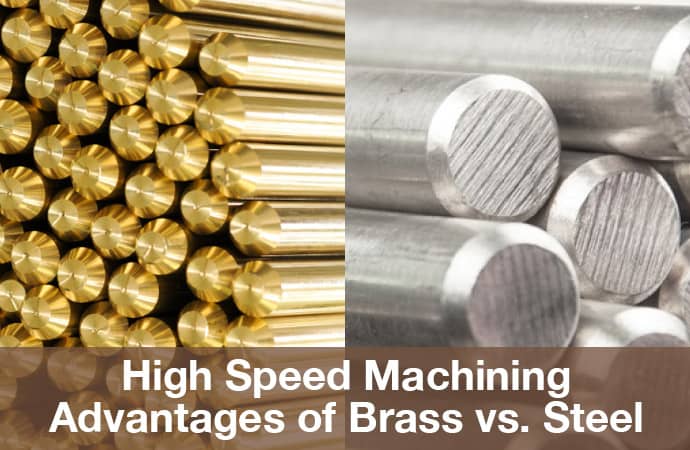To enhance productivity and profitability in objectively measurable terms, shops need to confront the drawbacks of specific materials and move past them. For example, among common production metals, 12L14 steel comes with inherent disadvantages, including low corrosion resistance and material removal rates. On the production line, running 12L14 steel shortens tool life, which adds downtime in the form of tool changes. Compared to brass, 12L14 steel offers less-desirable production parameters, but outdated handbooks and misguided perceptions can deter some shops from switching away from steel to take advantage of the strengths of brass.
Tradition often holds brass back. Some handbooks recommend overly conservative machining parameters for brass, often 85% slower than what modern high-speed machine tools can accomplish with ease. In fact, on modern machine tools, brass runs much faster than 12L14, with much longer tool life.
Along with old machining assumptions, design engineers also may believe that because the material purchase price for brass often is higher than for 12L14 steel, they should stay with steel to keep costs down. In reality, the high scrap value of brass – sometimes up to 90% of the raw material cost – makes the net material cost competitive between the two metals.
The material attributes of brass help it outperform steel in many cases, but some designers still view its mechanical properties as inadequate, despite the relative weakness of leaded steel, which cannot be heat treated. To many designers’ surprise, half-hard C36000 brass offers properties roughly comparable to steel, with 90% of the strength of cold-drawn leaded steel.
In fact, the strength of brass falls in the range between hot rolled (or hot rolled and cold reduced) 12L14 leaded steel. That strength alone makes it a safe substitute for leaded steel in most common screw machine products – and brass provides superior intrinsic corrosion resistance without the extra cost, uneven protection and environmental concerns associated with platings that 12L14 steel requires for some applications. Plated steel parts also suffer from lifespan limitations, as platings wear away and rust emerges to take its toll. Brass, of course, withstands a wide variety of corrosive environments unscathed and uncoated.
C36000 brass machines faster and produces better surface finishes than any other material of comparable strength. Its machinability rating of 100 puts it atop the list of production metals, with steel and stainless steel lagging far behind. Brass also avoids the need for the part-design compromises that often plague steel, including the need to build single parts out of multiple pieces welded together to overcome machining problems with poor chip formation.
Along with offering superior material properties, brass wins speed and efficiency comparisons in turning, drilling and milling, in part because of its machinability. In a high-speed turning and drilling test that compared five brass alloys (two free-machining; three lead-free) with 12L14 steel and 304L stainless steel, all brasses achieved dramatically higher material removal rates with excellent surface finishes and much longer tool life, all at speeds dramatically exceeding those for steel and stainless steel and at significantly lower power requirements to remove the same amount of material.
Test after test and real-world comparisons of production parts show that brass runs faster, with higher metal removal rates, lower power requirements and significantly longer tool life than steel and stainless steel. For example, when Ohio aerospace shop SPR Machine switched a part from 12L14 steel to brass, they achieved substantial productivity gains as a result. Head-to-head production tests of 12L14 steel, 304L stainless steel and brass (see chart) show that optimized high-speed machining yields dramatically high cutting speeds and metal removal rates with brass, combined with equally dramatic reductions in machining costs. These reduced production costs and increased throughput capabilities help expand production capacity and accelerate machine payback as well, ramping up the gains in manufacturing economics.
| Machining speed and cost comparison† | |||
| Turning | |||
| 304L stainless steel | 12L14 steel | Brass | |
| Maximum Cutting Speed with Acceptable Tool Life (surface feet per minute; carbide inserts) | 800 | 1,200 | 4,000 |
| Optimized High-Speed Metal Removal Rate (in3 per minute) |
3.02 | 4.54 | 21.6 |
| Machining Cost (per 1,000 in3 of material removed at $100/hr.) |
$550 | $370 | $80 |
| Drilling | |||
| 304L stainless steel | 12L14 steel | Brass | |
| Maximum Cutting Speed with Acceptable Tool Life (surface feet per minute; carbide inserts) | 250 | 800 | 2,000 |
| Optimized High-Speed Metal Removal Rate (in3 per minute) |
9.6 | 30.6 | 76.4 |
| Machining Cost (per 1,000 in3 of material removed at $100/hr.) |
$253 | $78 | $32 |
| †High-speed machining material optimization testing and analysis performed by TechSolve, Inc. | |||
| Adinamis, G., et al. (2019). High Speed Machining of Brass Rod Alloys. Modern Machinery Science Journal, November 2019, 3277-3284. doi: 10.17973/MMSJ.2019_11_2019082 | |||
For the sake of production efficiency and profitability, shops should reconsider out-of-date handbook values and preconceived notions about brass. Switching parts from 12L14 steel to brass can produce better parts, shorten cycle times, and reduce wear and tear on machine tools and tooling. On the bottom line, brass can improve productivity and profitability for manufacturers and their customers.


Recent Comments